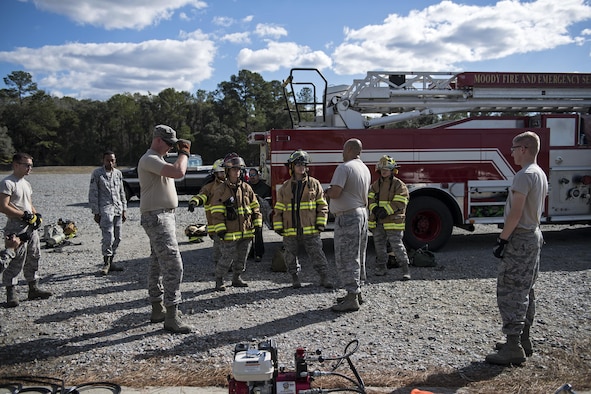 |
| A fire helmet rests on a seat, during Vehicle Extrication training, Jan. 13, 2017, at Moody Air Force Base, Ga. This training was included as part of an Emergency Medical Technician refresher course where students learned about vehicle extrication from Moody’s own firefighters. (U.S. Air Force photo by Airman 1st Class Janiqua P. Robinson) |
MOODY AIR FORCE BASE, Ga. --
The culmination of a week’s worth of classroom and hands-on training came to a head Friday as students ended their Emergency Medical Technician refresher course by participating in a Vehicle Extrication training, Jan. 13, 2017, here.
Students donned gear and used tools firefighters would use in the field to remove vehicle parts that would free a patient and allow them to be removed from the vehicle. They were instructed by firefighters, who know the importance of teamwork.
“It’s important for us to practice together because we’re going to be working together on scene,” said Tech. Sgt. Andrew Nickeson, 23d Civil Engineer Squadron, NCO in charge of the emergency communications center. “We have to work as a team and there’s no better way [to foster that dynamic] than through training.”
For this training, students wore firefighters bunker gear, which consists of three layers to protect the wearer from debris and extreme temperatures. The first layer prevents abrasive material from getting through the gear. Then the second and third layers provide protection from water and heat during a fire.
While it was important for students to know about the gear and what it’s designed to do, they also needed to know its limitations.
“For vehicle extrication, we wear our gear to protect us from sharp objects,” said Jeremy Valler, 23d CES crew chief. “If we’re cutting out a victim with hydraulic power tools, the bunker gear will stop minor impacts from injuring you, but, you’re not immortal in the bunker gear.”
While the bunker gear provides protection, the knowledge of how the tools work, and what firefighters do on scene for vehicle extrication helps keep everyone safe.
“They need to be knowledgeable about what we’re doing,” said Nickeson. “If they know exactly what we’re doing and why we’re doing it, it’s only going to make it that much safer on scene.”
Safety is the number one concern of first responders. Whether it’s keeping themselves safe, or ensuring the safety of the patients they rescue, they put safety first.
“We have to ensure that we’re all safe,” said Nickeson. “Responder safety is number one because if you get hurt, you can’t help anyone.”
 |
| Members of an Emergency Medical Technician refresher course, listen to final instructions, during Vehicle Extrication training, Jan. 13, 2017, at Moody Air Force Base, Ga. The students donned the top half of the protective gear to shield them from any debris during the training. (U.S. Air Force photo by Airman 1st Class Janiqua P. Robinson) |
See More Great Pictures